Making dumpling wrappers from scratch couldn’t be easier! In this section of my ultimate dumpling guide, you will learn to master this basic skill with ease.
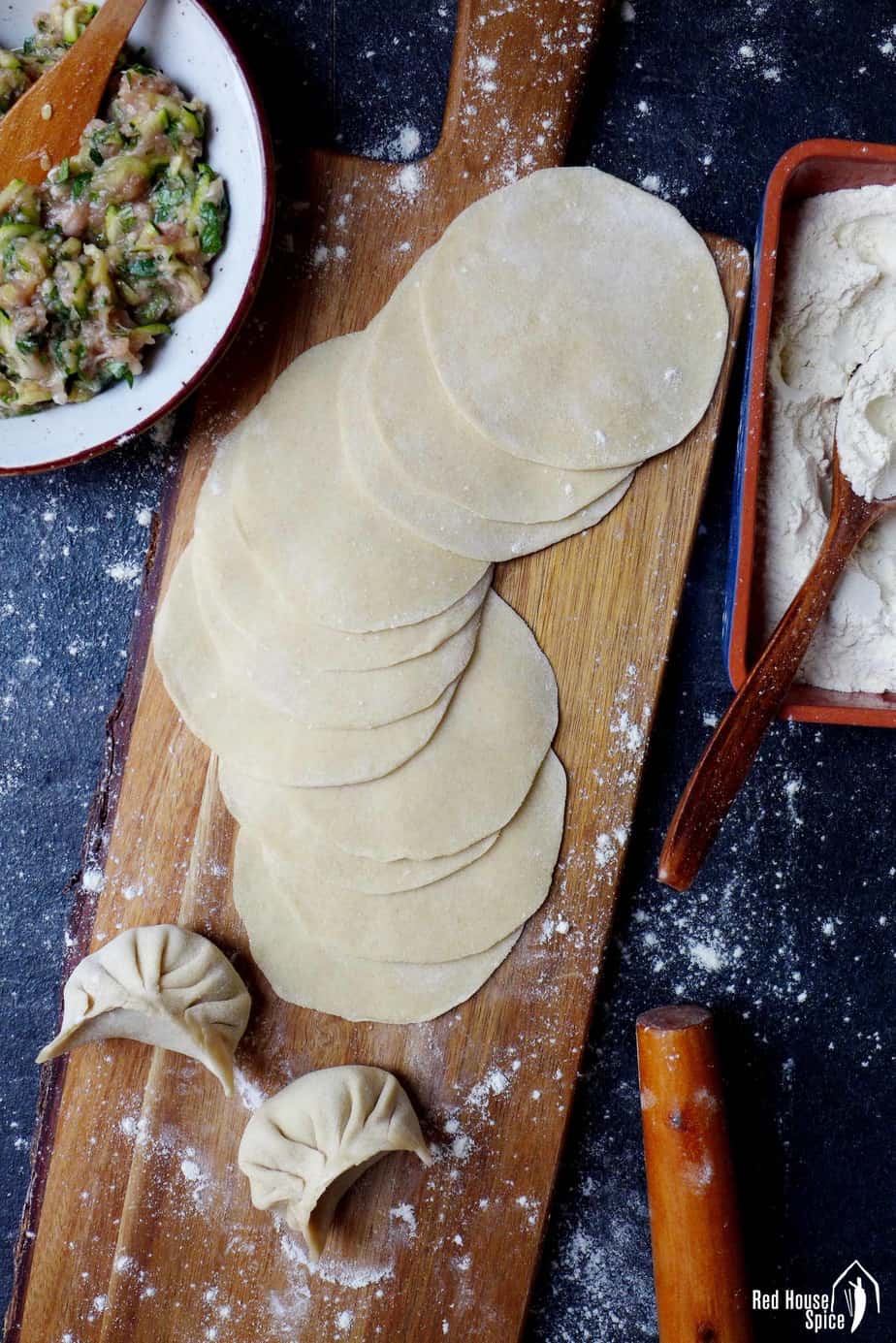
With the Chinese New Year (Spring Festival, 春节) fast approaching, I’ve decided to create a series of posts on Chinese dumplings to say THANK YOU to my lovely readers for another year of support.
This ultimate guide will cover all aspects of homemade dumplings, the iconic dish of Chinese cuisine. Today, we start the journey with homemade dumpling wrappers (饺子皮).
Jump to:
Which flour to use?
Let’s get down to the basics: what kind of flour is required for Chinese dumplings? Contrary to popular belief, you don’t need to buy flour produced in China or flour specifically labeled as “dumpling flour”. You can produce excellent dumpling wrappers using regular flour sold in your local shop.
The most common all purpose flour works just fine! However, it’s a good idea to understand your flour.
- Flour with a medium level of gluten works best. The dough is easy to work with. The cooked wrappers are tender but still have a pleasurable chewy texture.
- The gluten level varies in all purpose flour sold in different countries. Check the protein content on the nutrition label (per 100g flour).
- 10-11g = ideal
- 12-14g = more resilient
- under 10g = soft
The good news is that you can alter the texture if you wish.
- Like your wrapper softer: add some corn starch to the flour or make a hot water dough instead of regular cold water dough (Continue reading to find out how).
- Prefer a more resilient texture: add a little salt to the dough.
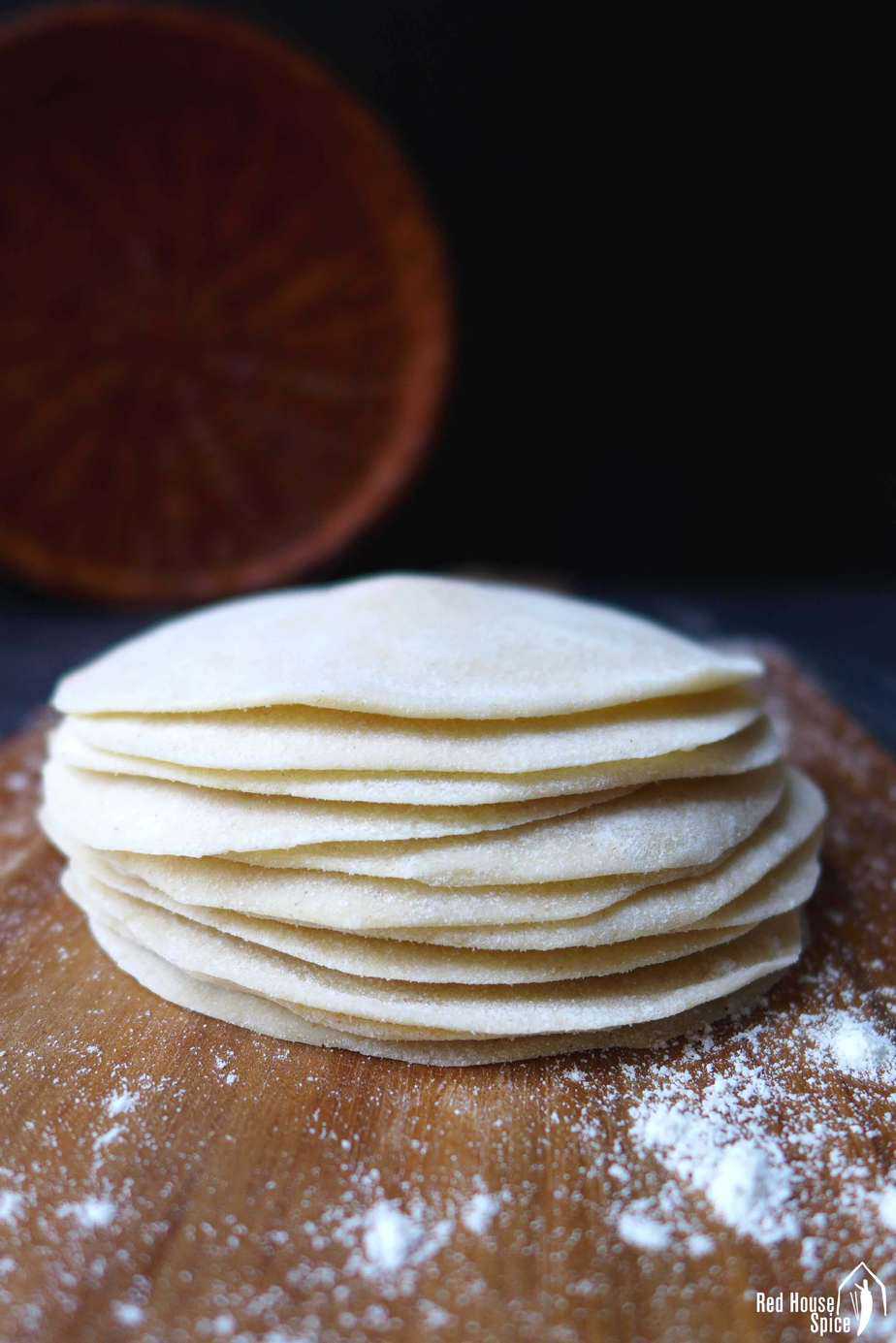
The flour water ratio
For making dumping wrappers, you would need a reasonably soft dough which is easily rolled but not so soft that it sticks.
Ratio:
- 250g / 2 cups all purpose flour
- 125-130ml / 0.5 cup water
*Please be aware that it’s less accurate to measure by cups.
This is the perfect ratio for me when using British regular plain flour (aka all purpose flour) which has a medium gluten level (10-11g protein per 100g flour). If you are using flour from another country, it might have a different water absorbing capacity. In general, the higher the protein content, the more water you would need to achieve the same consistency.
You might need some trail and error to find your very own perfect ratio. If you are new to homemade dumpling wrappers, I suggest you make the dough by hand for the first time instead of relying on a dough kneading device. This way you will be able to constantly “feel” the readiness of the dough and add more flour or water as required.
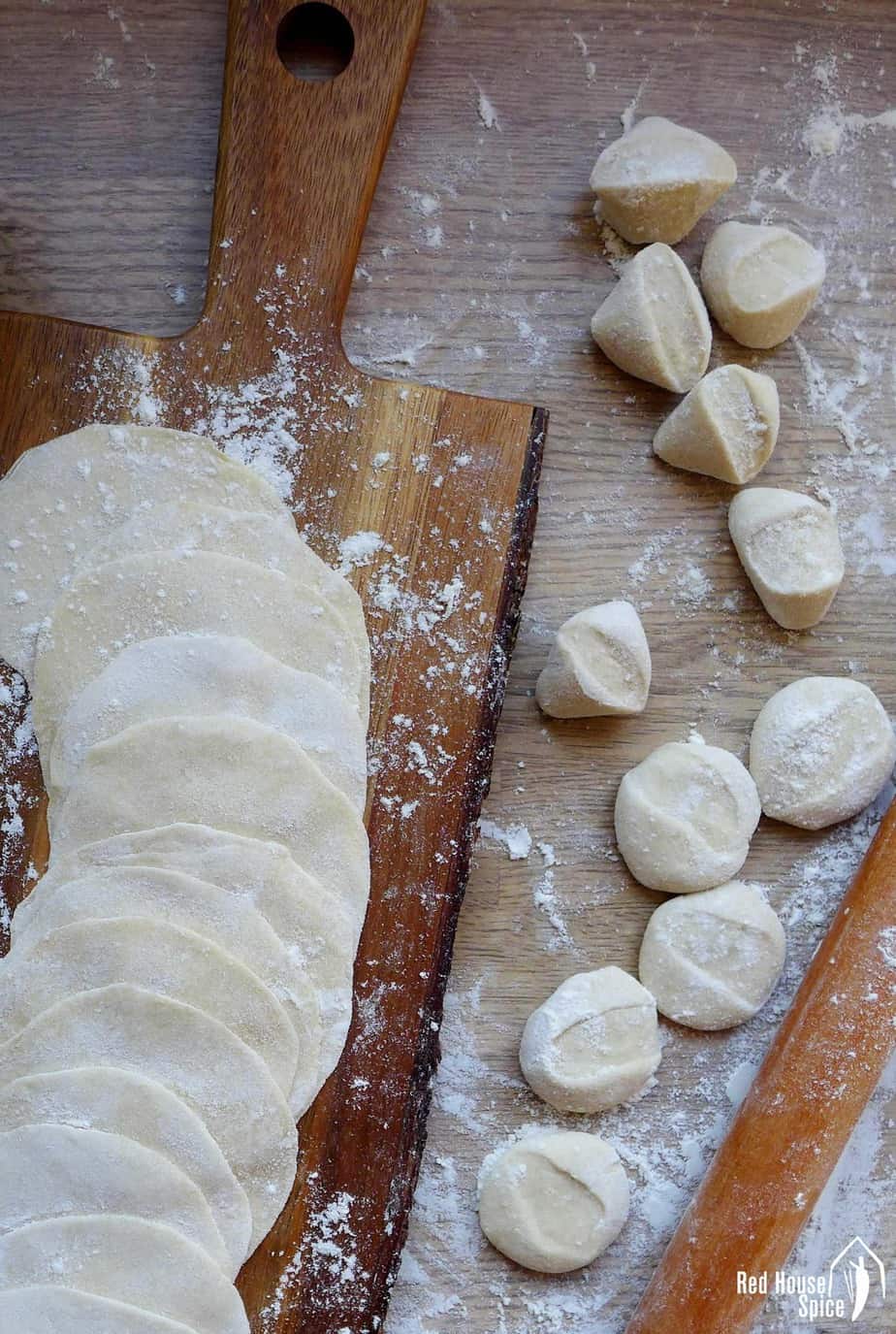
Make the dough by hand
I usually mix flour and water in a bowl. You can also do it directly on a flat floured surface. Add water to the flour gradually. Gently mix with a pair of chopsticks / spatular until no more loose flour can be seen. Then combine and knead with your hand.
At this stage, the dough ball should be medium firm and have a rough appearance. Leave it to rest (covered) for 10-15 minutes then knead it into a smooth ball. Cover and rest the dough a second time for at least 30 minutes.
The resting process will help to soften the dough. The longer it rests, the softer it becomes. If you use flour high in gluten, it’s better to rest it a little longer. A Chinese cook would say the finished dough should be “as soft as an earlobe”.
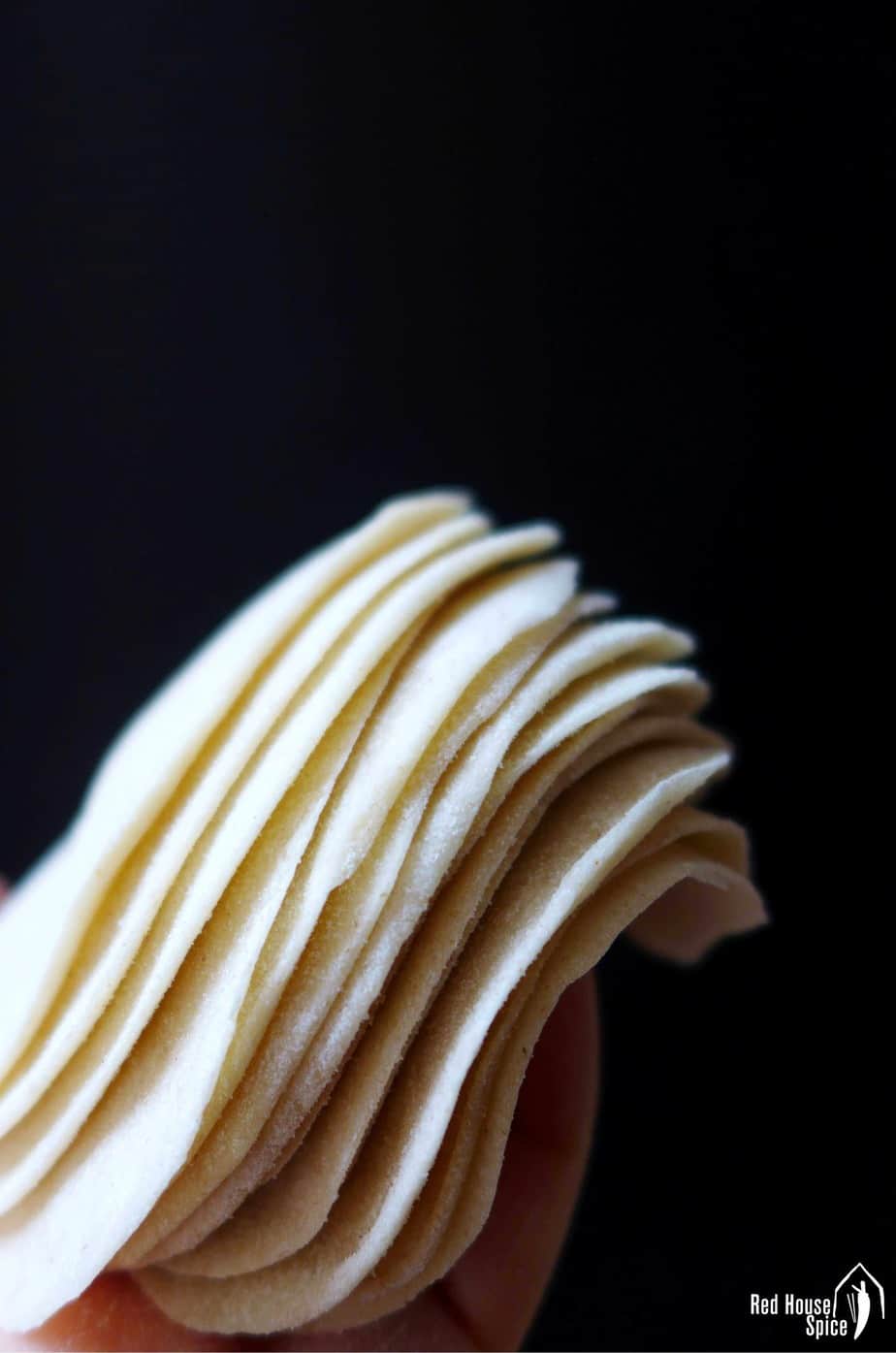
Other dough varieties
What I have outlined is the most commonly used all purpose dough for Chinese dumplings. If you prefer a dough that is more supple to work with and more tender when cooked, I recommend another two types of dough:
- Hot-water dough. Let’s say the total water required is 300ml. Firstly, mix the flour with 200ml of boiling water. Then add 100ml of room temperature water to the mixture.
- Semi-starchy dough. Replace about ¼ of the flour with corn starch. Don’t forget to sift to ensure an even mix. Wrappers made of this dough have a lovely shiny appearance when cooked and are tender on the palate.
These two types of dough work perfectly when the dumplings are either steamed or pan-fried. However, for water boiled dumplings I would suggest you use the regular dough.
* Some Cantonese dim sum dumplings use transparent wrappers that are entirely made of starch. Please refer to my post “Har gow: crystal prawn dumplings (虾饺)” for the wrapper recipe.
Shape the wrappers
Here comes the most intimidating part: rolling the dough into individual wrappers one at a time. I admit it’s a labour-intensive, time-consuming job. But when you get the hang of it, you can make them quite efficiently. Here are the steps (Please refer to the the video above):
- Make a loop / rope with the dough.
- Cut it into equal sections.
- Press each piece into a small disc with the palm of your hand.
- Use a rolling pin to flatten it into a thin disc.
Ideally, the wrappers should be thicker in the middle and thinner around the edge. So the edge of the dumpling wouldn’t be too thick after sealing. To achieve a good result when rolling out the dough, a particular hand coordination is required.
One hand moves the rolling pin halfway over the dough and then rolls back. The other hand turns the wrapper a little each time in a circular motion. Roll, turn, roll, turn…(see how it works in my video above). Once you’ve got the rhythm right, the perfect wrappers can be made in no time!
* Always remember to dust with flour if the dough sticks. Cover the unused dough to prevent it from drying out.
* Alternative way: Use a pasta maker to roll the dough into a thin sheet (similar to how you make wonton wrappers). Then cut out wrappers with the rim of a wine glass or something similar.
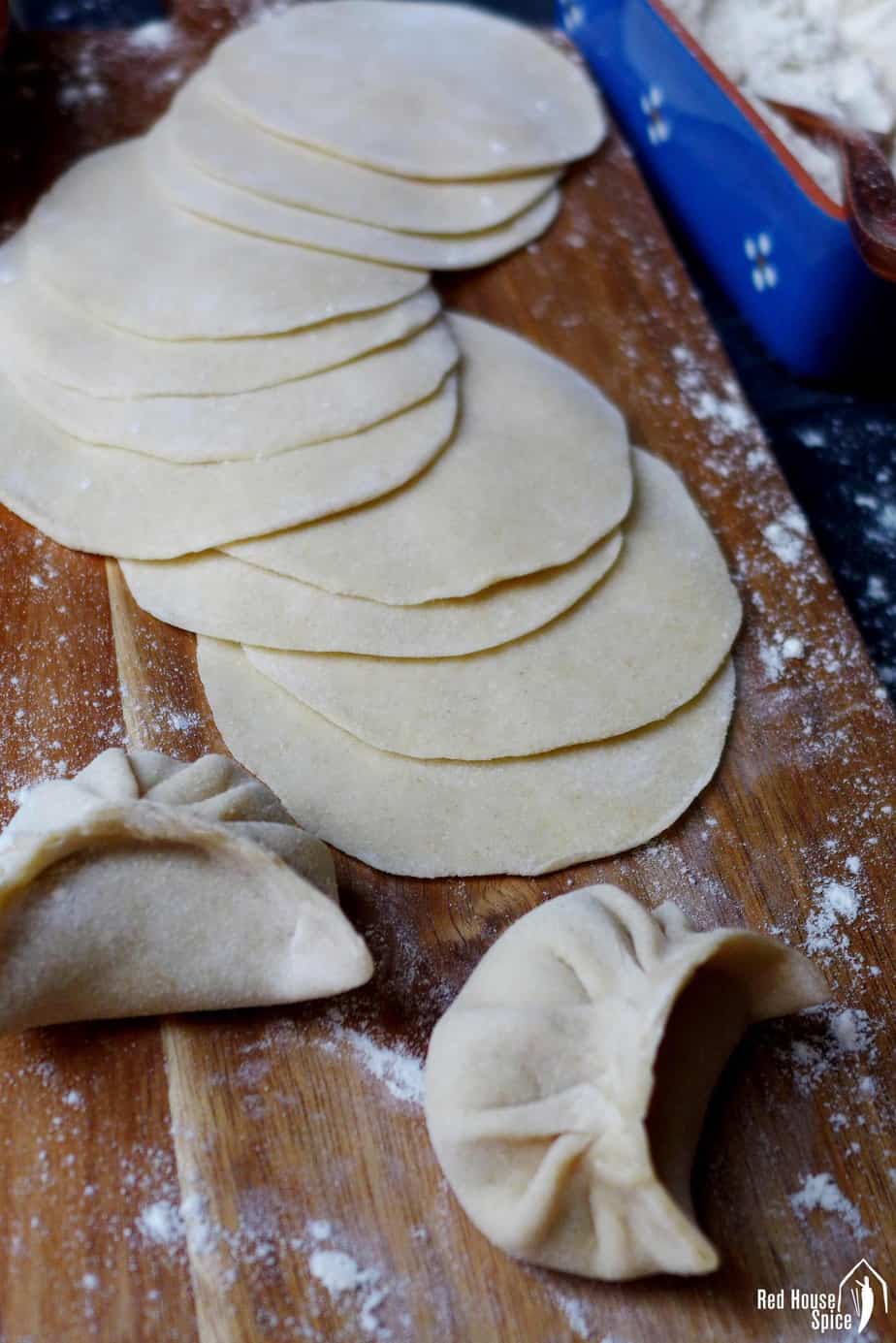
Store the wrappers
Freshly made dumpling wrappers need to be used immediately. Otherwise they become dry and difficult to shape. In Chinese households, making dumplings is usually a family activity in which everyone participates. So the wrappers are always used straightaway by those who are in charge of dumpling assembly.
If you are working alone, remember to roll less than 10 wrappers at a time and assemble them. Then get back to your rolling action to produce the next batch. Don’t forget to dust with flour if you wish to pile up the dumpling wrappers.
Make them in advance: Homemade wrappers can be frozen. Sprinkle extra flour (or even better, use cornstarch) in between each wrapper. Place them in an air-tight plastic bag (squeeze out the air as much as possible). Defrost in the fridge then use them straightaway.
Use up the leftovers: No dough is wasted in my Red House kitchen. I always use leftover dumpling dough to cook Cong You Bing (Scallion Pancakes). Even it’s just enough for a small one, I think it’s worth the effort.

Other dumpling recipes
Now that the wrappers are made, why not check out other dumpling-related posts?
📋 Recipe
Love this recipe? Please leave a 5-star 🌟🌟🌟🌟🌟 rating in the recipe card below & if you REALLY like it, consider leaving a comment as well!
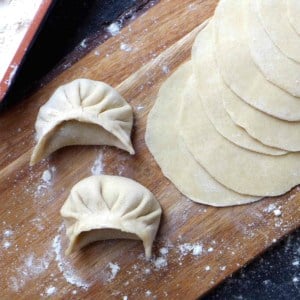
Homemade dumpling wrappers (饺子皮)
Ingredients
For making around 30 wrappers
- 250 g all-purpose flour - about 2 cups, plus some for dusting
- 130 ml water - ½ cup+2 teaspoon (see note 1)
Instructions
- Add water to the flour gradually. Gently mix with a pair of chopsticks / spatular until no more loose flour can be seen. Then combine and knead with your hand. Leave to rest covered for 10-15 minutes then knead it into a smooth dough (see note 2).
- Cover and rest the dough again for 30-60 minutes until it becomes soft (Chinese cooks would say “as soft as an earlobe”).
- Make a loop with the dough then divide it into four parts. Roll one part (cover the rest to prevent them from drying out) into a rope then cut into 7-8 equal sections.
- Press each piece into a small disc with the palm of your hand. Then use a rolling pin to flatten it into a thin disc. Dust with flour if the dough sticks (Please refer to the video below).
- Use the fresh wrappers immediately. If you wish to freeze them for later, sprinkle extra flour in between each wrapper. Pile them up then place into an air-tight plastic bag (squeeze out the air as much as possible). Defrost in the fridge then use them straightaway.
Video
NOTES
NUTRITION
NUTRITION DISCLOSURE: Nutritional information on this website is provided as a courtesy to readers. It should be considered estimates. Please use your own brand nutritional values or your preferred nutrition calculator to double check against our estimates.


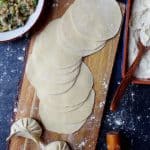
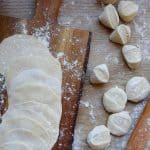
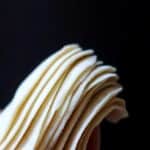
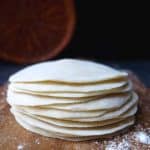
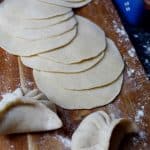
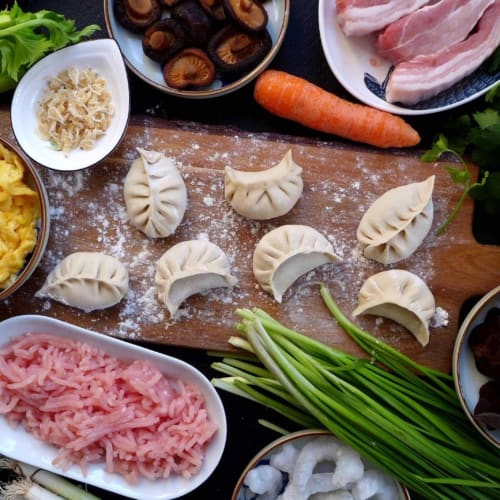
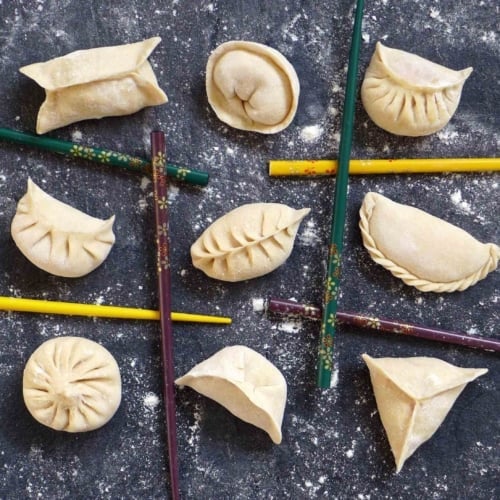
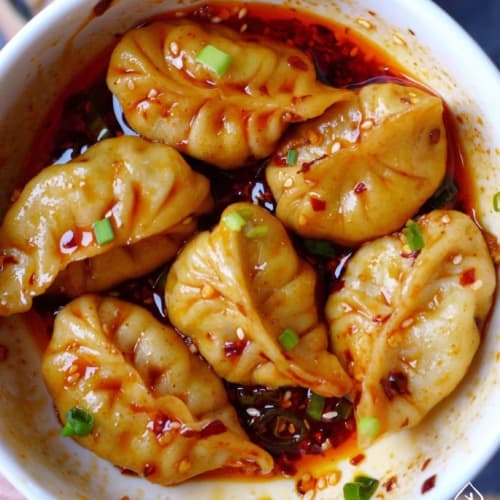
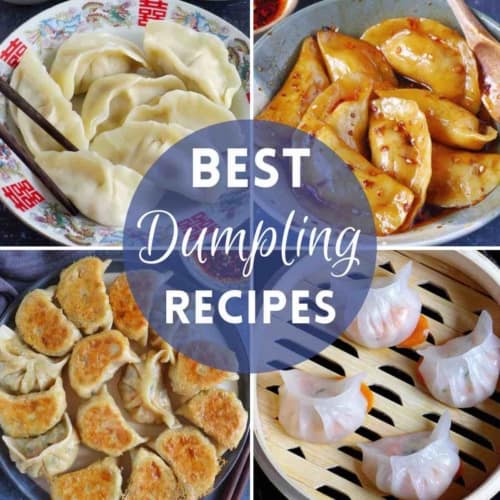
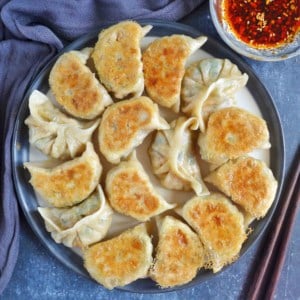

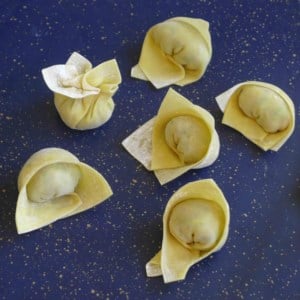
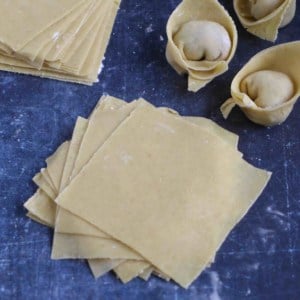
Thanks for your reply. I made a mistake it should be 1/4 cornflour
I have made all your 3 recipes for the dumpling wrappers.i like the hot water dough but not that using the cornflour cos it is abit chewy.
I usually make it the night before, put into fridge . The next day i will add the fillings and make gyoza for breakfast. It is good.thanks for all your delicious recipes.
You’re welcome Jessie! Dumplings for breakfast is such a great idea!
I like to make the semi starchy dough so will use 1/3 cornflour. The water of130gm will be tap water.is that correct? Pl let me know.
Thanks
Yes, Jessie. It’s tap water. As I suggested in the recipe, it’s fine to replace about 1/4 of the flour with corn starch. I think 1/3 is a little bit too much.
Hi Wei,
Do you think that a pasta rolling machine would work when rolling out the dough?? If so what setting should I use. Thanks
-Les
Yes, you may use a pasta machine to roll out sheets then cut them into circles with a wine glass or a scone cutter. In this case, you may reduce the water a little to make the dough a little firmer. 30 mins resting would be enough. Dust the dough with flour to prevent sticking. For dumpling wrappers, I’d use setting No. 5 on my pasta maker which make sheets about 1.5mm thick. Hope this is helpful!
Thanks for the reply .. Much appreciated.
Hi Wei, thanks for sharing your recipe and it’s nice to see a UK flour mentioned instead for once. I wondered if you had any suggestions on how this could be made more diabetes friendly? I.e. from flour that is more low carb, for example and how that might affect ratios? Thanks!
My pleasure to share Flick! I’ve never used low carb flour for this recipe so I’m not sure if it will work. I assume the texture and consistency will be very different.
I am planning on making these dumplings on Saturday and I am excited to do it; however, I have a question. Is it ok for the dough to be prepared in the morning and assembled at the evening? If yes, how should I do it? Thank you for your time!
Yes, you may prepare the dough in the morning. Then roll out the wrappers and assemble in the evening. Cover the dough properly to avoid drying out. Keep it in a shady, cool place. Since the dough will becomes softer and softer over time, I suggest you make the dough a little firmer (use a little less water). Otherwise it might be too soft after an extended period of resting. Happy cooking!
Thank you! We have an international student from China who has lived with us for several years. This year, due to the pandemic, he wasn’t able to go out to eat to celebrate the new year with his Chinese friends. I knew we couldn’t make up for him missing out on traditions so we decided to start a new tradition in our house. None of us, including him, had ever made a dumpling so we were so worried. We used your recipe and made the absolute best dumplings. He said they were some of the best he has ever eaten (I won’t tell his grandmother, but he said they were as good as or better than hers). Thank you for the recipe and the videos showing the techniques. I can’t wait to make dumplings again.
This message has made my day! I can tell how caring and kind you are, Andra! The Chinese student in your house is so lucky to have you and your family. I’m delighted to know you’ve enjoyed your New Year dumplings together. Food is indeed one of the best remedies for homesickness. I wish you, your family and that lucky boy a very happy and healthy Year of the Ox 💖.
For this recipe, can it be used to make gyoza wrapper where the pastry wrapper is thinner? Is it the same proportion of ingredients with plain flour and water, but rolled out thinner?
It’s the same thing. Please feel free to roll the wrappers to your desired thickness.
What a well written and thorough guide for dumplings and fillings. My first dough with your recipe came out ok, but after reviewing your comments and tips, my next dough was just what I wanted and the dumplings came out wonderfully. The filling and alternate dough recipes are so helpful and the rolling and forming videos helped my make my dumplings look like the ones in a restaurant. Thank you for doing such a great job here. I look forward to exploring more recipes on this site.
Hi Richard! Very happy to know you find my dumpling guide helpful. It’s my great pleasure to share!
Dear Wei,
this was the first time, that I myself made the wrappers for my dumplings (Semi-starchy dough) – thanks to your tips and recipe. It was perfect. I don’t buy ready to go wrappers next time, because this is much more fun to make and delicious!!!
I will go trough your page for more good tips and chinese finesse! Love from Budapest, Hungary 😀
That’s great to hear! Yes, it’s great fun making dumplings from scratch and they do taste better! Have a yummy year in 2021!
Your grams to cups conversion is off. 250grams is a little over 1 cup, not 2.
Thank you for popping by Fanzi! Cup is a measurement for volume while gram is for weight. Different substances weigh differently even if they share the same volume. 1 cup of water weighs a little less than 250g. However, since flour has a lower density (specific gravity), 1 cup of flour only weighs 120-125g. Hope this is clear.